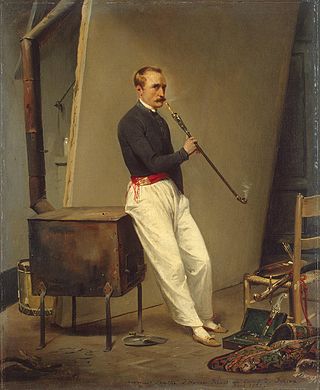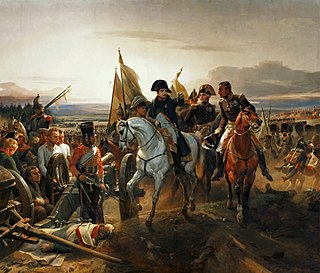
Émile Jean-Horace Vernet more commonly known as simply Horace Vernet, was a French painter of battles, portraits, and Orientalist subjects.

The Barrière de Clichy. Defence of Paris, 30 March 1814 is an oil-on-canvas painting by Horace Vernet from 1820. It shows a battle against Russian cossacks at the barrière de Clichy, highlighting the soldiers present but not engaged in fighting. Vernet's participation in this battle marked his only experience in active combat, which influenced his choice of subject matter for the remainder of his career.

The Battle of Friedland is an 1835 history painting by the French artist Horace Vernet. It depicts the Battle of Friedland fought on 14 June 1807 in East Prussia during the Napoleonic Wars. The battle was a decisive victory for French forces over their Russian enemies. At the subsequent Treaty of Tilsit, Napoleon was able to dictate peace terms to his beaten opponents. It is also sometimes known as Napoleon at the Battle of Friedland.

Joseph Vernet Tied to a Mast During a Storm is an 1822 history painting by the French artist Horace Vernet. It depicts a famous, possibly apocryphal, incident from the life of the artist's grandfather the marine painter Joseph Vernet who lashed himself to the mast of a ship in order to witness the effects of a storm. He had received a commission from Louis XV to paint a series of pictures depicting the ports of France and after departing Italy had run into a violent storm. As a rising artist Horace Vernet promoted his connection with his celebrated grandfather but quickly developed a reputation as a prolific and versatile painter in his own right.

The Battle of Jemapes is an 1821 history painting by the French artist Horace Vernet. It depicts the Battle of Jemmapes fought on 6 November 1792 near Jemappes in modern-day Belgium. Stylistically it is part of the developing romantic movement in art.

L'Atelier is an 1821 painting by the French artist Horace Vernet. It depicts the interior of his Studio located on the Rue des Martyrs in Paris. It depicts Vernet in his studio with art students. The artist is shown fencing in the middle of the canvas, with an épée in one hand and a Palette in the other. To emphasise his lineage as a painter Vernet included a bust of his grandfather Joseph and a painting of his father Carle's painting The Triumph of Aemilius Paullus.

The Salon of 1824 was an art exhibition held at the Louvre in Paris between 25 August 1824 and 15 January 1825. It took place during the Restoration Era that followed the downfall of Napoleon's French Empire. At the time one of Europe's premier art exhibitions, the Salon was held roughly biennaly during the period. It was the first to be held since Charles X succeeded to the throne earlier the same year.

The Battle of Valmy is an 1826 history painting by the French artist Horace Vernet. It depicts the Battle of Valmy, one of the earliest battles of the French Revolutionary Wars fought on 20 September 1792. The revolutionary French troops defeated an advance by a coalition of Foreign forces under the command of the Duke of Brunswick.

The Battle of Montmirail is an 1822 history painting by the French artist Horace Vernet. It depicts the 1814 Battle of Montmirail during the Napoleonic Wars. It was one of four battle scenes Vernet painted on a commission by the Duke of Orleans, a cousin of Louis XVIII and himself a future monarch of France. Vernet received a total of thirty eight thousand francs for the four works. It depicts the Battle Montmirail, one of the final victories of the French emperor Napoleon. Fought on 11 February 1814 during the Six Days' Campaign, Napoleon's success there ultimately didn't prevent the fall of Paris and his abdication two months later.

Portrait of Jérôme Bonaparte is an 1811 portrait painting by the French artist François Gérard depicting Jérôme Bonaparte, then the King of Westphalia. The younger brother of Napoleon, Emperor of France, he had been placed on the throne of the newly-created Kingdom in 1807 and held it until it was dissolved following the Battle of Leipzig in 1813. He is presented in coronation robes. The same year Gérard helped secure a commission for the young artist Horace Vernet to paint an equestrian portrait of Jérôme.

Portrait of Carle Vernet is an 1804 portrait painting by the French artist Robert Lefèvre depicting his fellow painter Carle Vernet.

Raphael at the Vatican is an 1832 history painting by the French artist Horace Vernet. It depicts an encounter in Rome between the Renaissance artists Raphael and Michelangelo. It is in the collection of the Louvre, in Paris.

Edith Recovering Harold's Body after the Battle of Hastings is an 1827 history painting by the French artist Horace Vernet. It depicts the aftermath of the Battle of Hastings in 1066 during the Norman Conquest of England, where the English monarch Harold Godwinson was defeated and killed in the fighting.

Portrait of Marshal Saint-Cyr is an 1821 portrait painting by the French artist Horace Vernet. It depicts Laurent de Gouvion Saint-Cyr, a former Marshal of the Empire under Napoleon. In 1817 he was appointed as Minister of War during the post-war Restoration era.

Massacre of the Mamelukes is an 1819 history painting by the French artist Horace Vernet.

Duck Shooting is an 1824 genre painting by the French artist Horace Vernet. It pays homage to the artist's father Carle Vernet who was very influenced by British sporting paintings and prints. It depicts a duck hunt in the marshes. Vernet often made reference to the works of his father and grandfather Joseph Vernet, both noted painters. It was exhibited at the Salon of 1824 in Paris along with its pendant piece The Quarry. Both paintings are now in the Wallace Collection in London.

The Salon of 1819 was an art exhibition held at the Louvre in Paris between 25 August and 30 September 1819. It was the largest Salon to be staged since the fall of Napoleon. It took place during the Restoration era with Louis XVIII on the throne. It was the first to be held since the withdrawal of Allied Occupation forces from the country at the end of the previous year. The two officials behind the exhibition the Count Forbin and Vicomte de Senonnes set out to make it even more a celebration of the House of Bourbon that the previous Salon of 1817.

The Salon of 1831 was an art exhibition held at the Louvre in Paris between June and August 1831. It was the first Salon during the July Monarchy and the first to be held since the Salon of 1827, as a planned exhibition of 1830 was cancelled due to the French Revolution of 1830.
The Salon of 1822 was an art exhibition held at the Louvre in Paris, opening on 24 April 1822. The Salon took place every two or three years at the time and featured paintings and sculpture. One of the most notable works to be displayed was The Barque of Dante by the romantic painter Eugène Delacroix, which owed much to Théodore Géricault's The Raft of the Medusa which had appeared at the previous Salon of 1819. Taking place during the Restoration era, it was the last to be held during the reign of Louis XVIII. The Salon of 1824 took place after his brother Charles X had succeeded to the throne.

The Salon of 1814 was an art exhibition held at the Louvre in Paris from 5 November 1814. It was the first Salon to be held since the defeat of Napoleon and the Bourbon Restoration that brought Louis XVIII to the throne. It featured a mixture of paintings and works of sculpture.



















